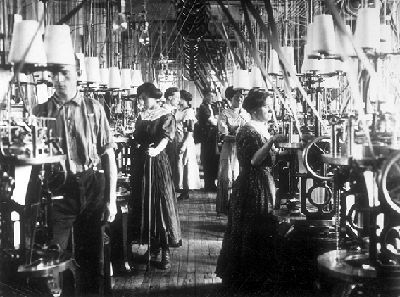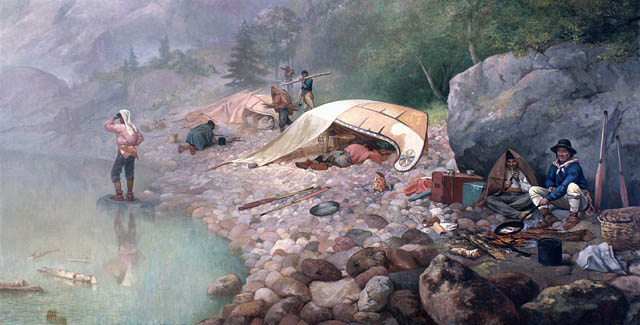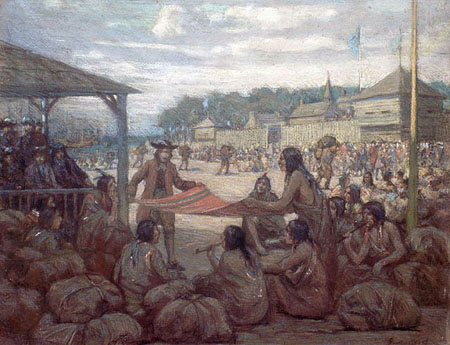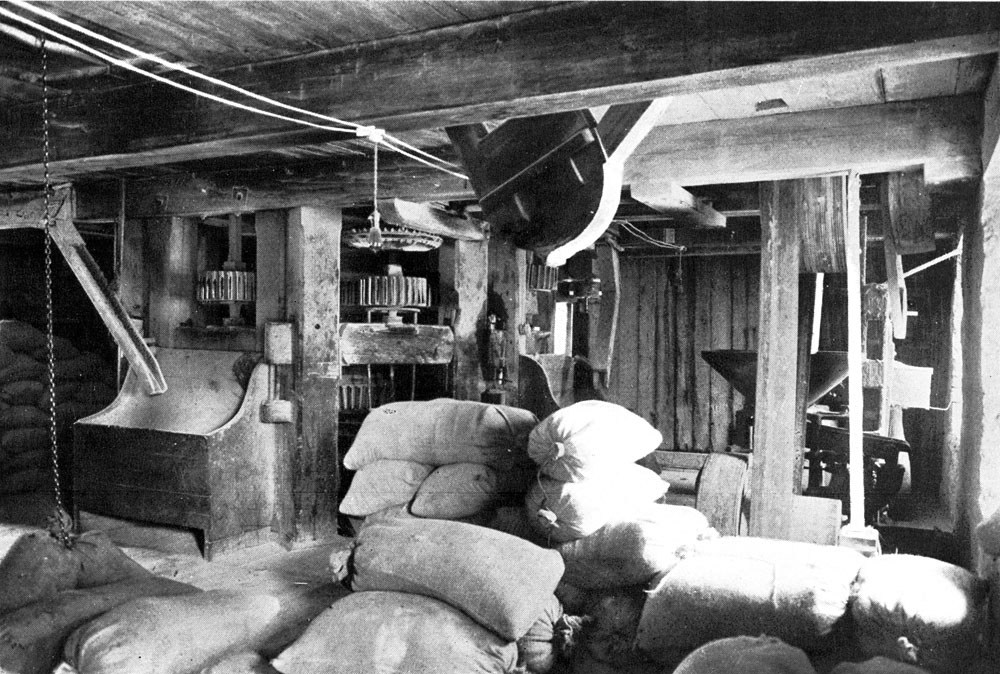This entry is one of three survey entries on the economic history of Canada. (See also Economic History of Atlantic Canada and Economic History of Western Canada.)
Early Economy
Most of the Indigenous peoples of what is now Central Canada lived by hunting and gathering; though, agriculture was established in many nations, especially among Iroquoian-speaking nations such as the Huron, Haudenosaunee, Petun, Neutral. Fur-bearing animals were trapped to provide clothing, and silver and copper were used to make ornaments. Trading among Indigenous nations for a wide variety of items was common, but there does not seem to have been any specialized merchant class. In the 16th century, French and British traders began to buy furs, for which they offered iron tools and weapons. The result was profound economic and cultural changes among Indigenous peoples, who were to play a critical role in the early fur trade.
Permanent European settlers first came to Canada to exploit the fishery and the fur trade (see New France). Until the end of the 17th century, because the climate and soil were not encouraging, agricultural progress was slow (see History of Agriculture). Like the French, English-speaking merchants engaged in the fur trade; after the Conquest (1759–60) — when many British businessmen began to control a large portion of the fur trade from Montreal — they also quickly extended their interests throughout commerce and finance. The population grew through natural increase and through immigration from Britain.
By the 1820s, the good agricultural land in the St. Lawrence Valley had almost all been taken up. After the North West Company merged with the Hudson’s Bay Company in 1821, the transcontinental fur trade was no longer managed from Montreal. But by that time, Upper and Lower Canada had developed an immense trade in timber, which went first to Britain and then, after mid-century, to the United States and to domestic buyers (see Timber Trade History).
Until the 1780s, there was no significant European population in present-day Ontario, although its waterways were used by the fur traders. Settlement began with the arrival of the United Empire Loyalists, British and American settlers, and British troops and officials. Forest land was gradually cleared, and export trades in wheat, potash and timber developed. A few roads and canals were built, of which the most important were the Welland Canal and St. Lawrence River canals. By 1867, most good land in the province had been claimed, although not all of it was under cultivation.
Confederation and Industrialization
At the Conquest, present-day Quebec contained three towns, Montreal, Quebec City and Trois-Rivières. Ontario contained none. But new towns soon appeared along with settlement and with the development of commerce and government. Yet even in 1871, much of Central Canada’s industry, including the two great industries, milling and lumbering, was dispersed through the countryside or in small villages. After Confederation, however, rapid industrialization and urbanization occurred in both provinces, so that by 1911 half of Ontario’s population lived in cities and towns.
From 1870 to 1900, some established industries such as tailoring and shoemaking were becoming factory activities, and provincial governments began to regulate working conditions. Minimum wage legislation came much later, with Ontario adopting it partially in the 1920s. Some unions were created in the 1830s. By the 1880s, with the rise and decline of the American-based Knights of Labor, union activity increased. But relative to the non-farm workforce, union membership remained small until the 1940s, when federal and provincial protection was extended to unions (see Working-Class History).
Rise of New Industries

Central Canada’s industrial advance was especially rapid between 1896 and 1914, when the nation experienced investment and export booms. After 1900, a few industries such as carriage-making and blacksmithing declined. But new industries appeared: electrical equipment and chemicals in the 1890s, cars and aluminum after 1900, pulp and paper between 1890 and 1914, radio and home appliances in the 1920s and aircraft in the 1940s. Cheap hydroelectric power during this period helped accelerate industrial change, as did both world wars, and nuclear power in the 1970s (at least in Ontario). In both provinces labour was drawn from natural population increase and immigration.
There were cyclical downturns in the mid-1870s, the early 1890s, the early 1920s and especially between 1929 and 1933, with the Great Depression lasting until the start of the Second World War. Thereafter, economic expansion continued largely uninterrupted until another cyclical downturn in the early 1980s ( see Business Cycles).
Because so many of the newer industries were concentrated in Ontario, during the 1920s Quebec’s economic advance was less spectacular; although it shared fully in the development of pulp, paper and nonferrous metals, it took no part in the automotive industry, and little part in the electrical appliance industries. Also, because a higher proportion of Quebec industries were low-productivity activities that could not pay high wages, Ontario workers earned more on average than Quebec workers. After 1945, and especially after the 1960s, these gaps closed. Both federal and provincial authorities spent lavishly to attract factories into Quebec; indeed, the Quebec government owned plants in such industries as steel-making and auto assembly. Quebec’s birth rate also became the lowest in Canada, and average real wages rose.
Although the national financial centre had shifted from Montreal to Toronto by the beginning of the Second World War, Quebec’s financial system became more sophisticated and more francophone in its attitudes. In the 1970s and early 1980s, as anglophone business and professional people left a province in which they no longer felt at home, there was increasing scope for francophone expertise. Much more serious than the political uncertainty among investors in Quebec were the troubles of its established textile and clothing industries, increasingly threatened by cheaper goods from developing nations. The federal government provided advice, new kinds of protectionism and adjustment finance. Thanks to the presence of Northern Telecom and Bombardier, for example, Quebec became an important player in the high-tech and aerospace fields.
Farming
Agriculture in Central Canada began as a battle against forest and climate. The industry then passed through an export phase, and by 1900 it depended chiefly on the local urban markets, which it was not able to supply fully.

Around 1800, the farmers of the lower St. Lawrence produced an exportable grain surplus, but for most of the 19th century Quebec residents depended on grain from Ontario. In turn, for most of the century Ontario regularly exported grain not only to Quebec, but overseas. However, after 1880, as Ontario’s population rose while its wheat acreage declined, the province gradually imported more wheat from western Canada while increasing its output of oats and other fodder crops. Between 1871 and 1914, both Ontario and Quebec specialized increasingly in meat and dairy products. From the 1860s until the 20th century, much cheese, butter and Ontario bacon were sold abroad (see Pig Farming); thereafter, more of these goods were consumed within Central Canada. After the First World War, with the decline of the horse and the resulting fall in oats acreage, the shift to other fodder crops became even more pronounced and some land began to fall out of cultivation. Meanwhile, city growth encroached on farmland.
From Confederation to 1929, spasmodic efforts were made to extend the frontier of agricultural settlement in Ontario and Quebec. These efforts were not very successful, but by 1929 there were pockets of farmland around Lac Saint-Jean, the Ontario Clay Belt, Rainy River and Thunder Bay. More important for northern development were mining, and pulp and paper. These activities scattered small communities throughout northern Ontario and Quebec between 1886 (when the Sudbury nickel deposits were first exploited) and 1929.

Growth of Cities
By 1867, the great cities of Central Canada were Montreal and Toronto. The former began as a port and commercial centre. By mid-19th century, it was a place of industry, and by 1900 it was producing large amounts of clothing and textile products, electrical equipment, railway rolling stock and many light industrial products. It was also an important financial centre. Toronto, after a slow and inauspicious beginning, developed after 1867 on similar lines, much of its early prosperity being based on Great Lakes shipping. By 1900, both cities had energetic banks and insurance companies and active stock exchanges (see Toronto Stock Exchange). Both cities had begun to attract immigrants from central Europe and Italy. But it was largely natural increase and immigration from Britain that built the cities of Central Canada between Confederation and 1939. Indeed, before 1900 many Quebecers and Ontarians migrated to the US, where prospects were better; Canada was not managing to retain the natural increase of its own population. However, between 1900 and 1929, and again after 1939, economic prospects were so much better that emigration was no longer a problem. Really large-scale immigration from Italy and central Europe occurred only after the Second World War.
In Quebec and Ontario, as elsewhere in Canada, urbanization and industrialization were assisted by the thrift and diligence of the population, whose members were also willing to borrow funds and skills from abroad and, at least until the 1970s, to receive immigrants during times of prosperity. Educational arrangements helped, first by providing for general literacy; next, by arranging for higher liberal and professional education; and then, starting in the 1970s, by offering various sorts of specialized secondary and tertiary technological studies in, for example, engineering and agriculture.
By 1987, both economies had become very urbanized, and “service” industries and occupations were much more important than manufacturing, which in turn was more important than agriculture, forestry or mining. The earnings from service industries helped to balance Central Canada’s accounts with the rest of the country, a process to which the sale of manufacturers also contributed. This pattern of regional specialization had established itself between Confederation and 1900. While some may argue that federal trade policy (see National Policy) helped Central Canada at the expense of certain regions, the industrialization of Ontario and Quebec in itself was not created at the expense of others. Most of the two provinces’ markets have always been in Central Canada because that is where most Canadians live. Also, since the 19th century there have been export markets for many Quebec and Ontario manufactures — cheese, sawn lumber, cars, agricultural implements, pulp and paper, refined nickel and aluminum.
Developments elsewhere in Canada, especially in the West, helped accelerate Central Canada’s industrialization, but they did not cause it. Economic evolution had been similar on the southern side of the Great Lakes, where there is a similar pool of raw materials, capital, labour and skills. Indeed, because on the Canadian side there was more hydroelectric potential, plus nickel, gold, silver, uranium and plenty of pulpwood, in some respects circumstances were more favourable. Since 1878–79 Canada’s tariff has protected manufacturing industries, but locational advantages, not the tariff itself, ensured that most of that protected manufacturing would locate in Central Canada.
Decline in Manufacturing
Canada finished the 20th century with a low-valued currency in relation to the US dollar, because commodity prices remained depressed (see Exchange Rates). But the dawn of the 21st century meant a new chapter for the Canadian economy, particularly in Ontario. The Canadian dollar hit a low of US$0.64 in 2001. But as commodity prices recovered, the dollar began a climb to hit par with the US currency in 2002 (see Commodity Trading). The Canadian dollar has remained near or above par since. This turnabout prompted many Canadians to believe their economy had contracted so-called Dutch disease, in which a sudden increase in the value of a country’s natural resources forces up its currency — while forcing down exports and thereby hurting the manufacturing sector. The argument over Dutch disease prompted Mark Carney, Governor of the Bank of Canada, to quip in a 2012 speech: “Some regard Canada’s wealth of natural resources as a blessing. Others see it as a curse.” Indeed, commodity increases and the steady rise of the Canadian currency was accompanied by a fall in manufacturing activity. The sector’s share of Canadian gross domestic product (GDP) fell from 18 per cent in 2000 to 10 per cent by 2016.
Carney and most leading economists, however, believed commodity prices were made a scapegoat for what they called structural change in the Canadian economy. While a strong currency may be partially responsible for the manufacturing troubles, they said the sector’s decline was part of a trend across the advanced world. As Carney noted in the same speech, Canada’s manufacturing-to-GDP ratio was six percentage points below the average of members of the Organisation for Economic Co-operation and Development (OECD) in 1970. In 2012, it was three percentage points behind the OECD average.
The US experienced an even more drastic downturn in its manufacturing sector at the same time, even though it is a net commodity importer while Canada is a net exporter. The US dollar began a steady depreciation in 2002 as the Canadian currency appreciated. In the same period, currencies of two other commodity importers, Japan and the euro area rose along with the Canadian dollar.
Nowhere in Canada was the structural change in the economy in the 21st century more apparent than in Ontario, where factory employment in 2012 had faded to 11.8 per cent of total provincial employment from 23 per cent in 1976. In a report commissioned by the Ontario government, economist Don Drummond said Ontario residents had yet to grasp how the erosion of the manufacturing base was tearing away at the province’s traditional economic advantage. He said a strong Canadian dollar and the uneven performance of the American economy were to blame.
In another blow, in 2012 Ontario lost the distinction of producing more cars than the state of Michigan, the birthplace of the North American auto industry. Ontario had been the leading auto producer among all provinces and US states since 2004. Michigan produced 1.6 million vehicles in 2012, compared to 1.5 million for Ontario despite record Canadian auto sales. Both Michigan and Ontario have been facing stiff competition from Mexico, which has benefited from increased investment by the world’s auto companies because of its cheaper labour costs. In fact, Mexico had been producing more vehicles than either jurisdiction for a decade.
Ring of Fire
A new appreciation of Ontario’s abundant natural resources developed in the first decade of the 21st century, particularly in the province’s northern regions. The provincial government and financial markets became fixated with the giant Ring of Fire mineral field, 500 km north of Thunder Bay. Dubbed “Ontario’s oil sands,” the region is rich in reserves of chromite, nickel and gold worth more than $60 billion. But the region needs a massive amount of infrastructure such as roads and railway tracks to get the ore to the refinery stage. A major private-sector investor walked away from a Ring of Fire development because of government delays in approving funds to build the needed infrastructure. Meanwhile the Ontario and federal governments were locked in discussions about who should pay for what.
International Free Trade
Another victim of the change in centuries — at least initially — was Canada’s trade balance. Canada entered the 21st century with a string of robust trade surpluses fuelled by a low-valued currency. But a suddenly muscular Canadian dollar had led to consistent trade deficits by the second decade, prompting the government of Prime Minister Stephen Harper to order its overseas diplomats to focus on improving Canada’s economic interests around the world. By 2013, one in five Canadian jobs was linked to exports. As a result, the shift in foreign policy was hoped to create 40,000 new export-related jobs over five years. Trade Minister Ed Fast, who played a key role in negotiating a long-sought free trade deal with Europe in 2013, said another key objective over the five years was to double the 11,000 small and medium-size companies doing business in emerging markets such as China, India or Brazil.
The new focus on support for Canadian commerce overseas was a follow-up to the Harper government’s announcement in 2007 of aggressive pursuit of new free trade agreements. This was a continuation of policies by the former governments of Brian Mulroney of the Progressive Conservative Party and Jean Chrétien of the Liberals in the 1980s and 1990s respectively. The Mulroney government implemented the Canada-U.S. Free Trade Agreement in January 1989 and quickly began work on an expanded agreement to include Mexico in a North American trade alliance, which would eventually be implemented by the succeeding Chrétien government in January 1994, the North American Free Trade Agreement, or NAFTA, superseded the Canada-U.S. trade pact.
The Chrétien government followed up with two new free trade agreements in 1997 — one with Israel, the other with Chile. In 2002, the same government implemented a free trade agreement with Costa Rica. After 2007, the Harper government continued the momentum with free trade agreements with Jordan, European Free Trade Association (Switzerland, Iceland, Norway and Liechtenstein), Peru, all in 2009, Panama in 2010, as well as Honduras and Colombia in 2011.
The signing of the two North American agreements was expected to set the Canadian economy off to a new era. However, one constant remained — Canada’s dependence on the US market, which accounted for 86 per cent of Canada’s exports in the first years under NAFTA. This dependence prompted the Harper government to aim for more diversification from trade with the US, just as the government of Pierre Trudeau did under the Third Option initiative in 1972. However, the Harper government succeeded where other governments had failed. In 2013, it reached an agreement in principle with the European Union to implement the Comprehensive Economic Trade Agreement (CETA), which came into force in September 2017. In early 2018, the Liberal government of Justin Trudeau reached a deal on the Trans-Pacific Partnership, a trade agreement between Australia, Brunei, Chile, Japan, Malaysia, Mexico, New Zealand, Peru, Singapore and Vietnam. The agreement will come into force once it has been ratified by all member states.
Regional Economics — Summary
In 2016, Quebec accounted for $394.8 billion or about 20 per cent of Canada’s GDP. Quebec, which once held the coveted economic status Ontario now holds, has declined in relative terms during the past half century. Three developments played major roles in this trend. The first was the completion of the St. Lawrence Seawayin the early 1950s, which enabled ships to bypass Montreal and thus drastically reduced its importance as a major port.
This was exacerbated by political instability (see October Crisis, Quebec Referendum 1980 and Quebec Referendum 1995) and French-only language legislation which together, since the 1960s, significantly reduced the incentive of international businesses to locate there. The faster pace of development in some other Canadian regions also influenced Quebec’s relative decline. Despite these factors, Quebec’s manufacturing and agricultural sectors have benefited heavily from freer trade with the United States. Montreal remains Canada's second largest metropolis and its second business center.
In 2016, Ontario accounted for $794.8 billion or 39 per cent of Canada’s GDP. Much of Canada’s manufacturing sector — notably industries such as auto-making, food and beverage, fabricated metals and others — is concentrated in Ontario. (And within Ontario, manufacturing is largely concentrated in the south, between Windsor and Oshawa.) However, the province has increasingly shifted to a service economy. Service industries now make up 77.5 per cent of Ontario’s GDP, with manufacturing accounting for only 11.9 per cent.
Much of Ontario’s success relates to its central geographic position in Canada, its proximity to the United States market and access to waterways, which ease the import of raw materials and the shipment of finished goods to other Canadian ports and international markets. Two Ontario cities — Ottawa, the nation’s capital, with strong public sector employment, and Toronto, which has emerged as a global financial capital — have also been key motors to the province’s development.
(See also Regional Economics.)

 Share on Facebook
Share on Facebook Share on X
Share on X Share by Email
Share by Email Share on Google Classroom
Share on Google Classroom











